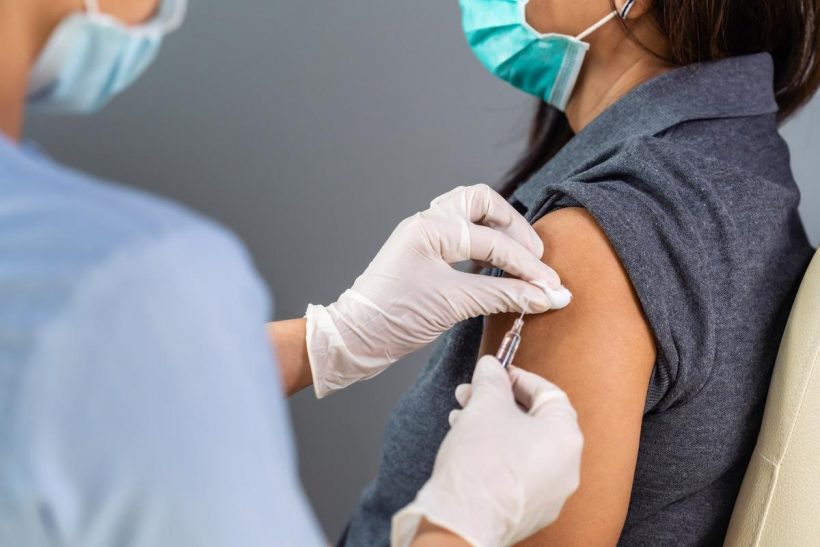In a recent study posted to Research Square* preprint server, researchers evaluated the immunogenicity of a third coronavirus disease 2019 (COVID-19) vaccination in antibody deficient subjects.

Background
Studies have reported that the antibody responses following two-dose vaccination against the severe acute respiratory syndrome coronavirus-2 (SARS-CoV-2) significantly diminish in those with primary immunodeficiencies (PID) and secondary immunodeficiencies (SID). The seroprevalence of antibodies against SARS-CoV-2 has been 54.8% post-double immunization, as estimated by the COV-AD (COVID-19 in Patients with Antibody Deficiency) study.
The reduced neutralizing potency of sera from doubly-vaccinated subjects against SARS-CoV-2 Delta and Omicron variants has been concerning. In light of this, the third vaccination with a messenger ribonucleic acid (mRNA)-based vaccine was recommended in the United Kingdom (UK) to augment the immune responses.
Few studies on immunosuppressed subjects have reported immunogenicity after the third vaccine dose. However, the immunogenicity in PID and SID subjects post-third vaccination has not been characterized. These individuals show inherent problems in mounting an immune response following infection or vaccination.
About the study
In the present study, researchers examined the immunological responses to a third COVID-19 vaccine dose in antibody deficient subjects relative to control subjects. Participants were recruited as part of the COV-AD study if they were aged 18 years or above and were recipients of immunoglobulin (Ig) replacement therapy, or antibiotic prophylaxis. A cohort of healthy participants was included as a control group.
The study participants received two BNT162b2 or ChAdOx1 vaccines in an extended schedule followed by a third BNT162b2 vaccine or mRNA-1273 vaccine. Where possible, venous blood or dried blood spot (DBS) sampling was carried out one-to-two months post-second vaccination (V2), up to four months before the third dose (V3), or one-to-two months post-third dose (V3). Otherwise, a single sample was collected randomly after the second vaccination without any fixed time point.
The samples were assessed for total antibodies against the SARS-CoV-2 spike (S) protein, which was reported as IgG, A, M (IgGAM) ratio, and results ≥ 1 were considered seropositive.
Seropositivity was defined as the proportion of seropositive subjects, and serological results were reported as median IgGAM ratios. IgG responses against SARS-CoV-2 Wuhan or Omicron S proteins were estimated with an in-house enzyme-linked immunosorbent assay (ELISA). Vero cells were used for live virus neutralization tests (VNTs). T lymphocyte responses were evaluated using a T-SPOT COVID assay based on the ELISPOT assay.
Results
The researchers observed a significant waning of anti-S antibodies in the six months post-V2. However, seropositivity was markedly elevated post-V3 in the COV-AD subjects. The IgGAM ratios were 1.88 and 4.54 pre-V3 and post-V3, respectively. This indicates that the magnitude of antibody responses in COV-AD subjects significantly increased post-V3.
Nonetheless, the responses were significantly lower in COV-AD subjects relative to control subjects. No significant differences in seroprevalence or magnitude of antibody responses were found between BNT162b2 and ChAdOx1 vaccinees post-six months of V2. Similarly, seroprevalence was insignificant post-V3 across the two cohorts of vaccinees.
Nonetheless, vaccine-induced responses were heterogeneous between PID and SID subjects. Notably, antibodies were not mounted in response to vaccines in those with X-linked agammaglobulinemia (XLA). Individuals with common variable immunodeficiency disorder (CVID) exhibited the lowest post-V3 seroprevalence and median IgGAM ratios.
Contrastingly, those with specific polysaccharide antibody deficiency (SPAD), the non-responders to pneumococcal vaccination, showed immune responses to COVID-19 vaccination.
Paired samples collected one to two months post-V2 and V3 were available for 64 individuals. Seroprevalence increased from 59.4% post-V2 to 75% post-V3 in the subjects, highlighting the immunogenicity of the third vaccine in non-responders. Additionally, paired specimens were available for 37 subjects at pre-and post-V3 timepoints.
IgG responses against Wuhan S and Omicron S proteins were evaluated in the subjects. At the pre-V3 point, IgG seroprevalence was 62.2% against Wuhan S protein and 40.5% against Omicron S protein, increasing to 78.4% and 67.5%, respectively, post-V3. Nevertheless, IgG seroprevalence was lower in COV-AD subjects relative to controls. Serum VNT performed against the Wuhan strain of SARS-CoV-2 revealed high neutralizing capacity after V3. T cell responses were detected in 47.5% of subjects post-V2, 46.4% pre-V3, and 59.6% post-V3 and were more prominent and quantitatively greater in individuals with COVID-19 history.
Conclusions
The study results showed that a third COVID-19 vaccination was associated with a significant increase in seroprevalence of anti-S protein antibodies among COV-AD subjects. Moreover, broadly cross-reactive immune responses were observed against Omicron. However, immunological responses were lower compared to controls.
Notably, 32.5% of the study participants failed to induce binding antibodies to Omicron. In COVID-19-naïve subjects, heterologous vaccination was associated with a high frequency of detectable T cells. However, whether further vaccinations would benefit those who could not mount a serological response following three vaccine doses remains to be investigated.
The authors of the present study recommended prioritization of non-responders to vaccines for antiviral or monoclonal antibody therapies if found SARS-CoV-2 positive.
*Important notice
Research Square publishes preliminary scientific reports that are not peer-reviewed and, therefore, should not be regarded as conclusive, guide clinical practice/health-related behavior, or treated as established information.
- Adrian M Shields, Sian E. Faustini, Harriet J. Hill et al. Increased seroprevalence and improved antibody responses following third primary SARS-CoV-2 immunisation: an update from the COV-AD study. Research Square. doi: https://doi.org/10.21203/rs.3.rs-1489715/v1 https://www.researchsquare.com/article/rs-1489715/v1
Posted in: Medical Science News | Medical Research News | Disease/Infection News
Tags: Agammaglobulinemia, Antibiotic, Antibodies, Antibody, Assay, Blood, Cell, Coronavirus, Coronavirus Disease COVID-19, covid-19, Enzyme, Frequency, Immune Response, Immunization, Immunodeficiency, Immunoglobulin, Lymphocyte, Monoclonal Antibody, Omicron, Prophylaxis, Protein, Research, Respiratory, Ribonucleic Acid, SARS, SARS-CoV-2, Severe Acute Respiratory, Severe Acute Respiratory Syndrome, Syndrome, T Lymphocyte, Vaccine, Virus, X-linked

Written by
Tarun Sai Lomte
Tarun is a writer based in Hyderabad, India. He has a Master’s degree in Biotechnology from the University of Hyderabad and is enthusiastic about scientific research. He enjoys reading research papers and literature reviews and is passionate about writing.
Source: Read Full Article
